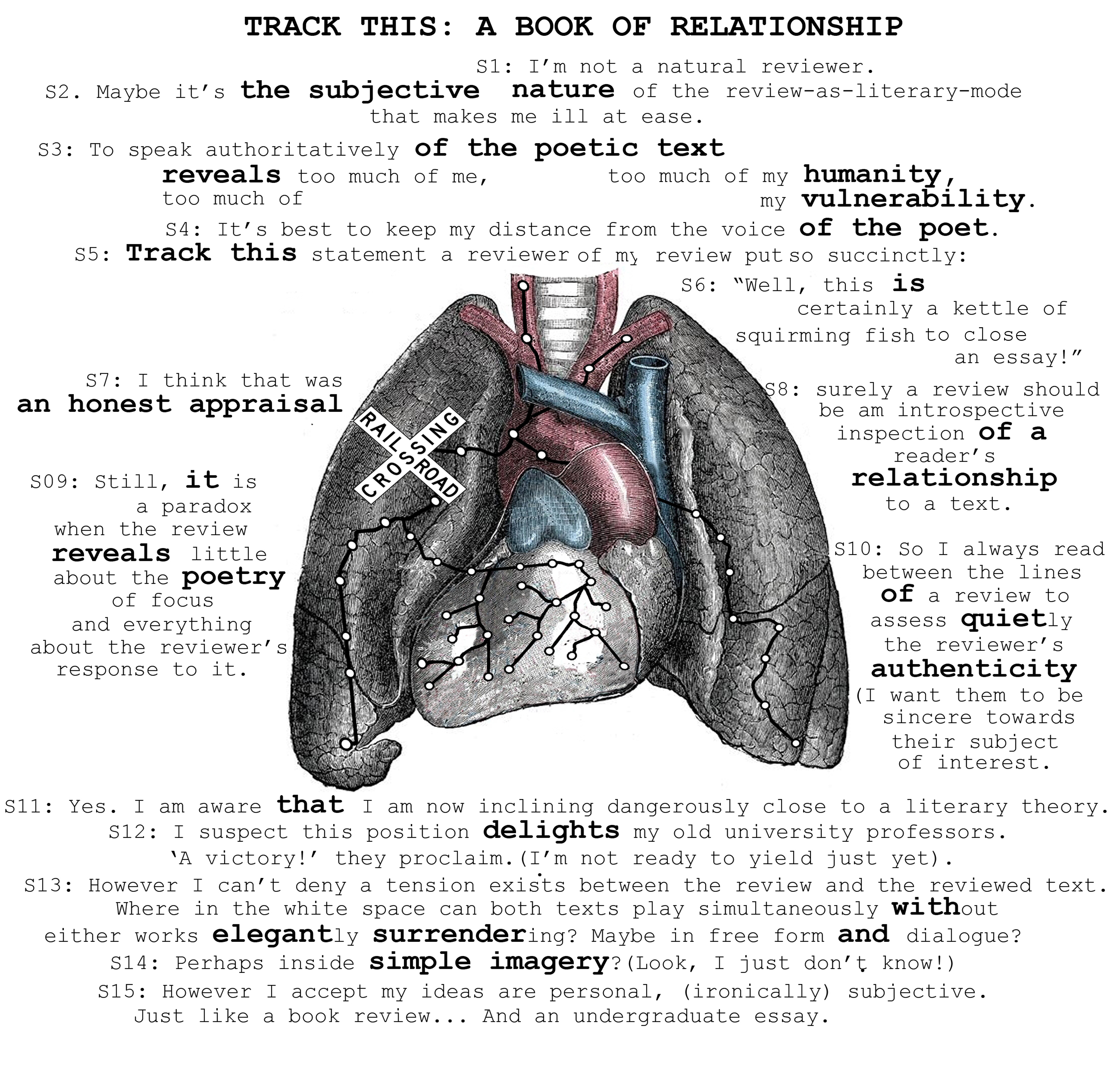Track This: A Book Of Relationship
Stephen Bett. www.stephenbett.com
BlazeVOX [books]. 2010. 148pp.
US$16.00.
ISBN: 978-1-60964-033-0.
Reviewed by Orchid Tierney.
Two Responses
I. The Review As Convention
Track This: A Book of Relationship is the eleventh poetry collection by Canadian poet, Stephen Bett. Divided into two sections, the collection puts a fledging relationship under the poetic microscope, tracking the high-rises and depressions – the metaphorical geography of the heart. Part one, Untracked, commences the collection with a sequence of fifteen poems that showcases the human singularity in the world: man alone, man observing, or better still: man against (if we treat man as a compromised entity). On page 26, the reader is introduced to the poem ‘Gee,’ which illustrates the definitive style of this collection:
How many G’s for
a G-string? This
month’s bill from
the divorce lawyer
– she asks six
(& change)
String theory
never had it
so straight
up
Bett’s poetry are offerings: they expose themselves like nude paintings, providing only the essentials and inviting the reader to extrapolate interpretation based on the subjective reading. This is authentic minimalist poetry. The words are so modestly beautiful in their arrangement upon the white page while showing an emotional intelligence within the micro-text. So much is left unsaid. It’s true that as a reader I have little patience for poetry forms that seek to clarify or to explain. Such forms spoon-food the unimagined reader. By contrast, Track This is akin to a lolly-scramble: Stephen Bett scatters an array of words but it’s up to the individual reader to determine what’s inside the wrapper.
Poetic minimalism is notoriously difficult to master, especially on a topic as complex as humanrelationships. Yet Track This manipulates the sparse format so aptly that the outcome is a poignant expression of the tensions that exist between two people. At times, the collection demonstrates the understated gentleness of the English language with a human voice that makes the poetry so accessible to the layperson (while it beckons multiple readings from the widely read). To satisfy both types of readers is an incredible accomplishment.
Part two, Tracking, traces the relationship between the poet and his ‘Pamela’ from its tentative beginnings. The grammatical and linguistic brevity supports an urgency in the language. On page 76, the poem ‘The Map (you give me)’ delivers a short burst of impressive imagery:
You point out
places & it’s
like doors
opening
Hallways
filled w/
sudden
light
I’m left wondering why this verse is so enduring since on the surface the poem, itself, is a simple pleasure. Yet within the micro-text, I’m left with quiet vignettes of emotion. Each short line builds the poem into a momentum. Do we, as the readers, respond to the image of opened doors with anticipation or nervousness? Do we move beyond the threshold? Do we stay inside the darkened room? The imagery has a life beyond its own words and in the process, draws the reader into the poem. We become witnesses to the poet’s candid self-observations, his truthfulness and vulnerability as a man which is best demonstrated in the poem ‘Permission’ (page 54):
I give you
permission
to break
my heart
Such feeling is reinforced again on page 55, ‘Not a Guilt Tripper, A Love’:
I dip into
sadness
There is no
bottom
to that well
Moments like these can be read aloud with a single breath, which places the poetry in the here and now. The reader is left with the relief of continuance that suggests our capacity for love and sadness is the human engine. While each work exists quietly as an autonomous entry, I think the satisfaction of the collection rises from its structure which – while not narrative – links poem to poem with motifs of compass directions, train tracks, hands in motion that create a sense of forward movement. Overall, Track This shows a vision of poetry which combines concise language with genuine depth of feeling. Or to use the analogy: Stephen Bett’s poetry exposes the single cell of a human hand. Good poetry might allow the reader to see the wider picture but excellent poetry celebrates the moment.
BUY IT from BlazeVOX [books]
Or direct from Amazon.com
II. The Review As Literary Mode
– Heart and lungs jpeg is adapted from a lithograph found in Gray’s Anatomy, 1858. It is not a representational image of the book, Track This –

